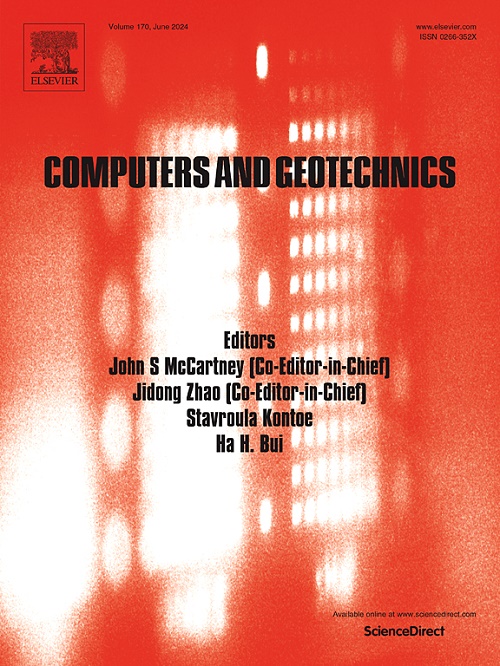超重力对非混相两相驱替过程的CFD模拟和双通道解析模型研究
IF 6.2
1区 工程技术
Q1 COMPUTER SCIENCE, INTERDISCIPLINARY APPLICATIONS
引用次数: 0
摘要
重力对多孔介质中提高采收率和二氧化碳地质封存等两相驱油过程有显著影响,但其定量评价有限。本研究建立了以第三轴为修正界数(log(Bm))的三维相图,区分了粘性指理、稳定位移和毛细指理两个重力主导区域(重力指理和重力稳定位移)。该图表是基于指法准则的无量纲分析,该分析来源于一个简化模型,该模型量化了重力、粘性力和毛细力的影响。确定了一个阈值速度,将重力和粘性力竞争下的稳定位移与指动分离开来。此外,在不同重力和速度的各向同性多孔介质中进行了一系列CFD模拟。模拟结果与解析结果一致:与位移方向相反的重力效应((ρi-ρd)g<0)有利于由指压向稳定位移的过渡,提高了位移效率,促进了注入压力的增大趋势;而重力效应与位移((ρi-ρd)g>0)方向相反。本工作的系统研究加深了对重力两相驱替的认识,为流体操纵和提高采收率或二氧化碳封存技术的发展提供了参考。本文章由计算机程序翻译,如有差异,请以英文原文为准。
Hypergravity effects on immiscible two-phase displacement processes via CFD simulation and an analytical bi-channel model
Gravity significantly influences two-phase displacement processes in porous media such as enhanced oil recovery and CO2 geological storage, yet its quantitative evaluation has been limited. This study establishes a three-dimensional phase diagram with the third axis as modified bound number (), distinguishing two gravity-dominant regions (gravitational fingering and gravitational stable displacement) from viscous fingering, stable displacement, and capillary fingering. The diagram is based on nondimensional analysis of fingering criterion derived from a simplified model that quantifies the effects of gravity, viscous force, and capillary force. A threshold velocity is identified, separating stable displacement from fingering under the competition of gravity and viscous force. Additionally, a series of CFD simulations were conducted in isotropic porous media incorporating various gravity and velocity. The simulation results aligned with analytical findings: gravitational effect in the opposite direction as displacement () favored the transition from fingering to stable displacement, increased displacement efficiency and facilitated the increasing tendency of injection pressure; while gravitational effect in the same direction as displacement () did the opposite. The systematical investigation in this work deepened the understanding of two-phase displacement involving gravity, serving as reference for fluidic manipulation and development of EOR or CO2 storage.
求助全文
通过发布文献求助,成功后即可免费获取论文全文。
去求助
来源期刊

Computers and Geotechnics
地学-地球科学综合
CiteScore
9.10
自引率
15.10%
发文量
438
审稿时长
45 days
期刊介绍:
The use of computers is firmly established in geotechnical engineering and continues to grow rapidly in both engineering practice and academe. The development of advanced numerical techniques and constitutive modeling, in conjunction with rapid developments in computer hardware, enables problems to be tackled that were unthinkable even a few years ago. Computers and Geotechnics provides an up-to-date reference for engineers and researchers engaged in computer aided analysis and research in geotechnical engineering. The journal is intended for an expeditious dissemination of advanced computer applications across a broad range of geotechnical topics. Contributions on advances in numerical algorithms, computer implementation of new constitutive models and probabilistic methods are especially encouraged.
 求助内容:
求助内容: 应助结果提醒方式:
应助结果提醒方式:


